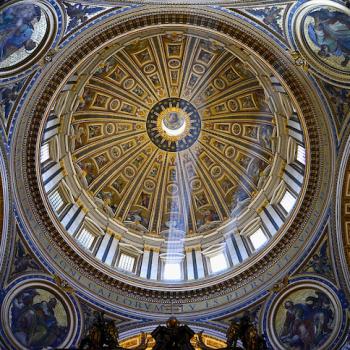
Following straight on from the Nativity, Matthew Three pivots the gospel narrative unexpectedly from Jesus’ infancy to his ministry. The tiny Saviour grows up in the blink of an eye. No sooner do the wise men honor the new-born king in Chapter Two than the man Jesus’ warm-up act arrives on the scene: John the Baptist.
In comparison to the other Gospel writers’ presentation of John, there is a real mystique surrounding Matthew’s Baptiser. John appears in verse one to no fanfare, neither biographical details nor backstory given. Luke, on the other hand, affords equal space to John’s childhood as to the Lord’s Annunciation in his opening chapter.
John is a mysterious figure with a gospel to preach. And of all places to begin a ministry, John sets up in the Judean wilderness. Judea was the land where King David reigned. And so, Judea’s plunging valleys were a fitting place to proclaim the Christ. You see, Matthew aims to trace Jesus’ ancestry through David (1: 1, 6, 17, 20), so he cleverly stresses Judea – David’s Kingdom – as important in the Gospel story.
Verse two distils John’s teaching: “Repent, for the kingdom of heaven is at hand!” (NKJV). Another John, the French reformer John Calvin, comments on this message in his Institutes. ‘By announcing the kingdom of God, he [John the Baptist] called for faith,’ writes Calvin, ‘since by the kingdom of God which he declared to be at hand, he meant forgiveness of sins, salvation, life, and every other blessing which we obtain in Christ’ (3.3.19).
Calvin, ever insightful, has more to say regarding these words: ‘do they not deduce repentance as a consequence of the offer of grace and promise of salvation? The force of the words,’ he reasons, ‘is the same as if it were said, As the kingdom of heaven is at hand, for that reason repent’ (Institutes 3.3.2).
In verse three, we have another link to the Hebrew Bible. Matthew reveals John to be the herald of a new dawn, ‘the one of whom the prophet Isaiah spoke.’ And so, John stands in continuity with Isaiah’s witness, proclaiming one Lord of all creation. Be that even so, God is doing a new thing in Israel, which Isaiah couldn’t imagine in his time. That is, Jesus’ incarnation as one of us.
To publicize Our Lord’s appearance in human flesh is John’s vocation. He performs, decades later, the role the happy star over Bethlehem did. Whereas, however, the star was a cryptic sign that only the wise could understand, we have in John a preacher who speaks to the typical person in plain speech.
As for John’s physical appearance, there’s no forgetting a man who goes around in a camel’s hair shirt, eating six-legged snacks and wild honey. (Rather than what? House-trained honey?) John’s affinity for glazed insects is akin to the dietary habits of a modern hipster. It’s a memorable description, for sure.
Now, Matthew’s portrait of John is a fine addition to the chapter. ‘Ford Madox Ford,’ recalls Flannery O’Connor in Mystery & Manners, ‘taught that you couldn’t have a man appear long enough to sell a newspaper in a story unless you put him there with enough detail to make the reader see him’ (92). The same applies to prophets trying to sell a gospel, I suppose.
And in the fifth verse, Matthew subtly reminds us that we care for the community where we live in the first instance, and only then go global with ministry. John’s parish – contra the Methodist refrain, ‘the world is my parish’ – was Judea, Jerusalem and the banks of the Jordan. I never thought I’d agree with a Gospel Coalition article, but I found a good one on this point.
Evidently John is creating a stir in Palestine. He draws his audience from all over the local region in a way that any pastor today would envy. From Jerusalem’s urbanites to the country folk in the surrounding area, people from all walks of life are dying to hear John speak.
Won over by John’s vision, those who feel so compelled step into the Jordan for baptism, owning their misdeeds and receiving full pardon. ‘We acknowledge one baptism for the forgiveness of sins,’ every Christian professes in the Nicene Creed. As it was in John’s day, so it still is now.
Here, in this comment on baptism, we have another hint as to how place is important in the Christian tradition. John baptises converts in a highly significant river: the Jordan. Do you remember Naaman the Syrian leper? He washed in the Jordan on Elisha’s instruction and was cured of disease, as we read of in 2 Kings 5. In the same way, baptism and repentance mediate our healing from sin.
Though not everyone came to the shrubby banks of the Jordan with good intentions: namely, the Pharisees and the Sadducees. There is always risk of antisemitism when discussing Pharisees and Sadducees from a modern Christian perspective; although Jesus was always careful – heated as his exchanges were with rival groups within Judaism – to play the proverbial ball rather than the man.
John’s question to them is a strange one: “Who warned you to flee from the wrath to come?” (NRSV). It’s unusual because the logical answer is, of course, “Uh… you did.” It seems John is being ironic as the Pharisees and the Sadducees have chosen to gloss over the core imperative of repentance in his message.
If we can take one lesson from John, it’s this: “Bear fruit worthy of repentance” (v. 8). Yes, it’s a little obscure. But we can illumine it with other passages which employ fruit imagery. Galatians 5 is a good example: ‘the fruit of the Spirit is love, joy, peace, patience, kindness, generosity, faithfulness, gentleness, and self-control’ (vv. 22-23).
Repentance enables us to bear holy fruit. We cannot bear love till we renounce hate. We cannot bear peace till we renounce war. We cannot bear kindness till we renounce meanness. For something new to grow, the soil has to be turned; ‘every good tree bears good fruit’ (Matthew 7:17).
A major New Testament idea is that all who bear good fruit are welcome in the Kingdom of God – not only the children of Israel, as had been the case in the Old Testament. And it’s this reality to which John turns in verse nine: “Do not presume to say to yourselves, ‘We have Abraham as our ancestor’; for I tell you, God is able from these stones to raise up children to Abraham.”
St. Paul explains this doctrine in Romans Nine: ‘This means that it is not the children of the flesh who are the children of God, but the children of the promise are counted as descendants’ (v. 8). In other words, a person’s fate is not ordained according to birth or parentage – a liberating concept.
We must all – no matter our ancestry – be unmade in the purifying fire of God and remade in the likeness of Christ. “Refiner’s Fire” captures this well, if you’re into modern worship. As John had already said in this text, repentance is the first waystation on the road of refinement.
I believe in original sin – that each of us are equal in our need of salvation. John is talking about us all when he says, ‘every tree therefore that does not bear good fruit is cut down and thrown into the fire’ (v. 10b). We must all pass through the fires of grace on the way to Paradise.
Matthew brings his account of John full circle in verses eleven to twelve, to John’s role as the harbinger of a new deal between God and all creation. Christ is the one who comes from heaven as a man – Jesus the Nazarene – to seal this covenant in his own precious blood (see Luke 22:20).
And revealing this Jesus to be not only man but God as well – two natures in one fully human, fully divine person – John promises that his Lord will send the Holy Spirit, ‘who proceeds from the Father and the Son,’ so the Nicene Creed affirms. A baptism by fire, indeed.
We noticed how John is a speaker who addresses everyday people. In rural Judea this meant reaching for agricultural metaphors to get across a point – in this case, the drastic nature of our purification before we can see God. Here, John offers two such images: an axe cutting out infected roots (v. 10a), then the separation of wheat from chaff (v. 12).
It is Christ who decides what is good wheat and what is useless chaff in our lives. However, conforming to his vision for living well involves discerning – over the course of a lifetime, through making mistakes and rising again to do better – what it is to bear that ideal fruit.
On first reading it, we miss how crucial Matthew 3:1-12 really is in setting up the remaining chapters. It introduces virtually all the main Gospel themes: the kingdom of heaven (v. 2), repentance (vv. 2, 8, 11), the Christ (vv. 2, 11-12), sacrament (vv. 6, 11), inclusivity (v. 9), and the Holy Spirit (v. 11). That’s packing a lot into just a dozen verses!
As we continue to follow John’s ministry – and, naturally, the life of Christ – we now have a grounding in the main topics to watch as we mull Matthew’s Gospel. Nevertheless, John the Baptist is more than a plot device to move the narrative on from the manger to the mature Jesus. We have in John a prophet who ministered with devotion in word and sacrament – a model priest.
Each of us – whether ordained into priesthood or not – receives a calling in Matthew Three to bear fruit, as John urges, which reflects our status in Christ as a holy people. And is there anyone better than Christ as our ultimate role model – Jesus, the one who loved us enough to give it all?
4/29/2022 6:11:24 PM





